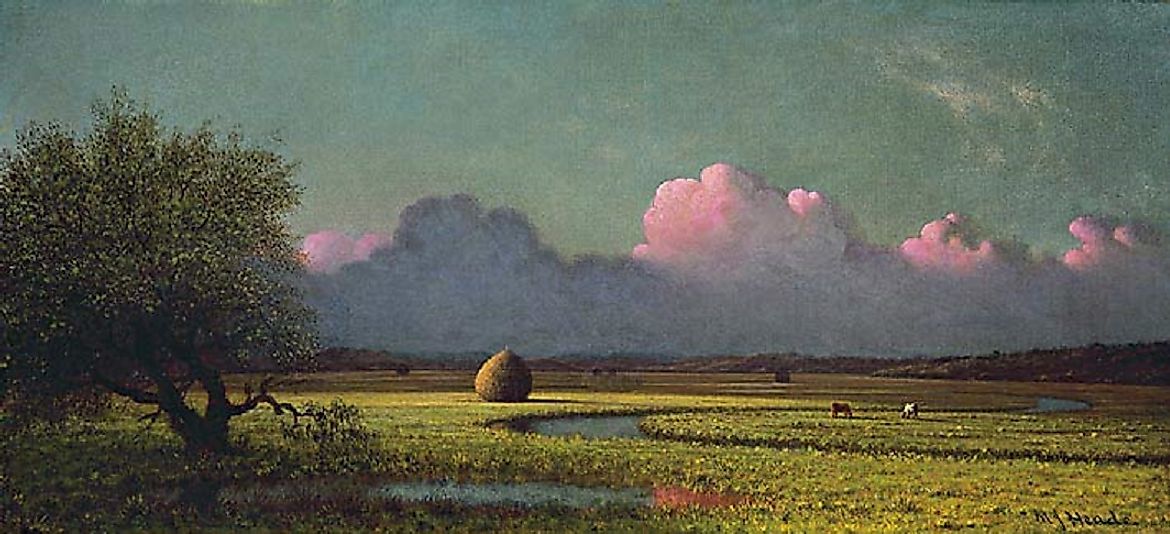What Was American Luminism Art?

In the Mid- and Late-19th Century, many American landscape painters placed significant emphasis on using the effects of light. American artists strove to capture the light they saw and hence the art of sketching outdoors early in the morning or late evening began. The landscapes of America with its numerous rivers, bays, waterways and beautiful coastlines inspired the artists to paint. The defining characteristic of the movement was the recreation of light reflected from water surfaces and atmosphere above the land. The silver tones luminance became a specialty of the American Luminism art. The writings and works did not inspire imitation of the European artists, rather a new dawn of light effects on canvas emerged. In 1949, John Baur wrote the first defining essay in regard to American Luminism.
5. Overview of the Style -
In the 1850s through 1870s, many American landscape painters adopted a painting style characterized by light effects on the landscape through the use of hidden visible brushstrokes, as well as using aerial perspectives. In a nutshell, Luminism and impressionism both share an emphasis on light effects. However, where Luminism focuses on concealing brush strokes and attention to detail, impressionism emphasis on brushstrokes and lacks detail. Luminism American art style targets tranquility, depicting a calm environment. Their paintings are landscapes or seascapes with smooth and slick reflective waters. The sky looks hazy and soft and usually represented as a long rectangle occupying around one-half of the composition. These paintings articulate a geometric organization where edges of concrete objects align parallel to the edges of the canvas. All their paintings had a hard linearism with detailed scenes and crystal clear models.
4. History and Development -
American Luminism Art developed as a spin-off of the earlier Hudson River School. Thomas Cole, the founder of Hudson River School, laid the foundations for the movement. Cole’s, 1836 “The Oxbow” piece of art detailing the foreground foliage and peaceful meandering of a river combined with a unique soft grayish light became a precursor to the style of light and the founding archive of Luminism. In that era, American landscape artists desired to capture images when the light was less bright by sketching in the morning and evening. This strive to express American light in an American Landscape became Luminism. 1954, the term “Luminism” was conjured by the Director of the Whitney Museum of American Art, John Baur. In contrast to the Hudson River School painters, these artists did not identify their work with Luminism. The art developed as a separate culture from the European painting. The closest European comparison to Luminism use of light effects on canvas was the works of Claude Lorrain, a French Baroque. The artist found inspiration in the Italian landscapes where he sketched the countryside and its horizon in the morning and afternoon light. During Luminism development, it was noted that the artist preferred to insert Native Americans camping above a river, or farm houses, boats on the river below, and also local hunters and wildlife. In contrast, the Europeans painted peaceful pastoral scenes with scattered crumbling ruins derived from ancient cities of Greece and Rome.
3. Notable Artists and their Works -
Martin Johnson Heade, considered a founding member of the American Luminism Art movement, was an artist who sought sublimity of the inner glow originating from his canvases, such as can be seen in his “Cherokee Roses in a Glass Vase” painting. Another prominent art preserved in San Francisco Fine Arts of Museums is Sunrise among the Rocks of Paradise, (1859) by John F. Kensett (1816-72). Fur Traders Descending the Missouri (1845) by George Caleb Bingham (1811-1879) is found at New York’s Metropolitan Museum of Art. In the same museum are the “Approaching Thunder Storm (1859) by Martin Johnson Heade (1819-1904), and John Frederick Kensett’s Lake George (1869). Other notable artists and their works include Long Island (1862) Private Collection of James Augustus Suydam and Pool in the Woods (1892) Private Collection of George Inness.
2. Decline and Subsequent Successive Movements -
Photography's development became a leading cause of Luminism's decline. Whereas artists once traveled with sketchbooks to various destinations to capture the essence of nature, photography, which developed in the 1820s and onward, brought cameras and their inherently faster speeds. This technology made it easier to capture life outside studios. As a result, portrait artists saw their efforts as less necessary and turned away from realism. In France, the decline of paintings led to the development of impressionism. Monet’s 1872 “Impression Sunrise” heralded the end of Luminism and birth of impressionism and at the same time glorified the artistic divinity of Luminism as a bright sun spreading its rays across the gray ripples of water. Nevertheless, a cameras veracity and speed could never equal or compare to the American landscapes and marine-scape beauty as captured by the eye of an artist and executed by an expert hand. Another movement that succeeded Luminism was Tonalism which developed in 1880 to 1915. The artists here painted American landscapes with an overall mood or shadow tones. Dark and neutral hues characterized the paintings. Similar to Luminism, Tonalism was eventually declined by Impressionism and Modernism. With all these emerging movements Luminism faded into a minor art until John Baur in 1949 wrote the first detailed essay on American Luminism.
1. Legacy -
Luminism artists inspired Americans to advocate for the preservation of the natural beauty found in American’s scenic wilderness and forests. John Muir writings and the works of Emerson and the Transcendentalists influenced the opinions of powerful and wealthy industrialists with the aim of advocating for the preservation of West American landscapes as an important piece of nature, and not mere venues to exploit for their own financial gains and business deals. The movement's artistic work with its peculiar fascinations of white, gray, and silver light became uniquely American, giving Americans a unique legacy.







